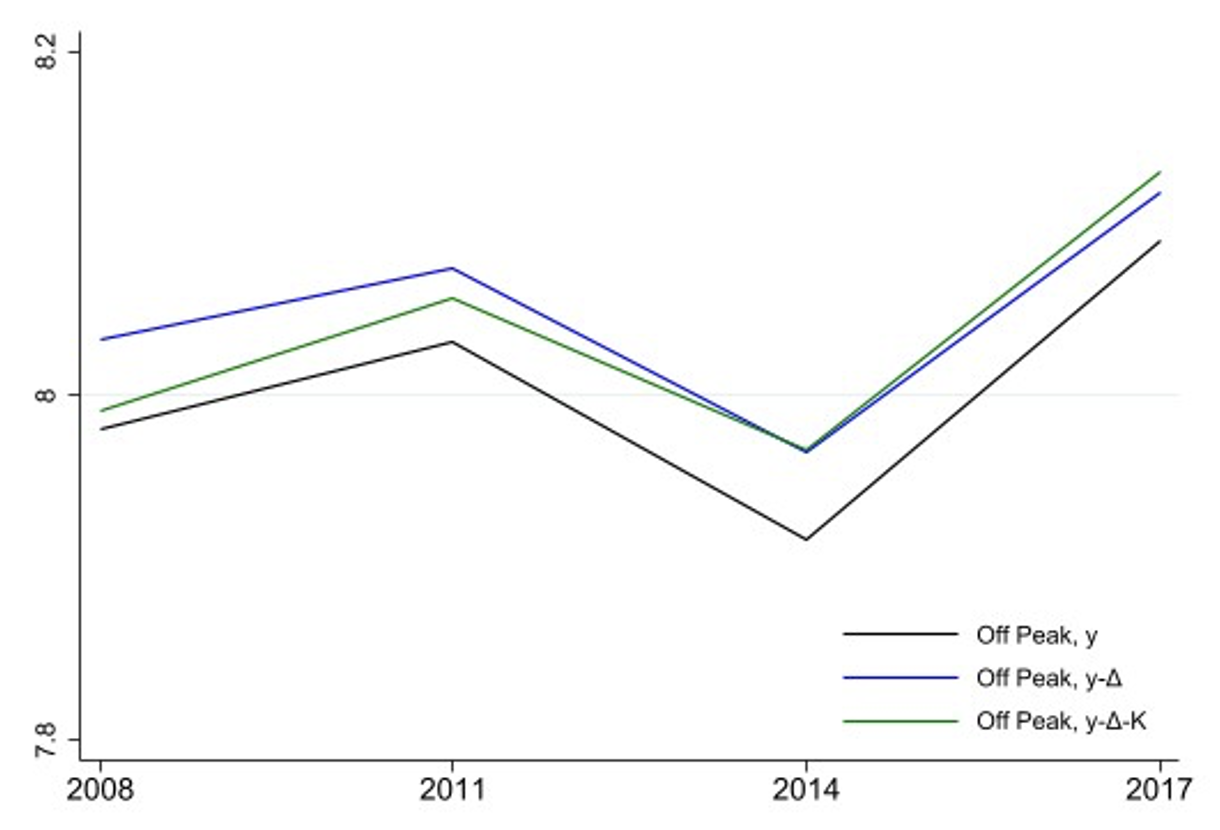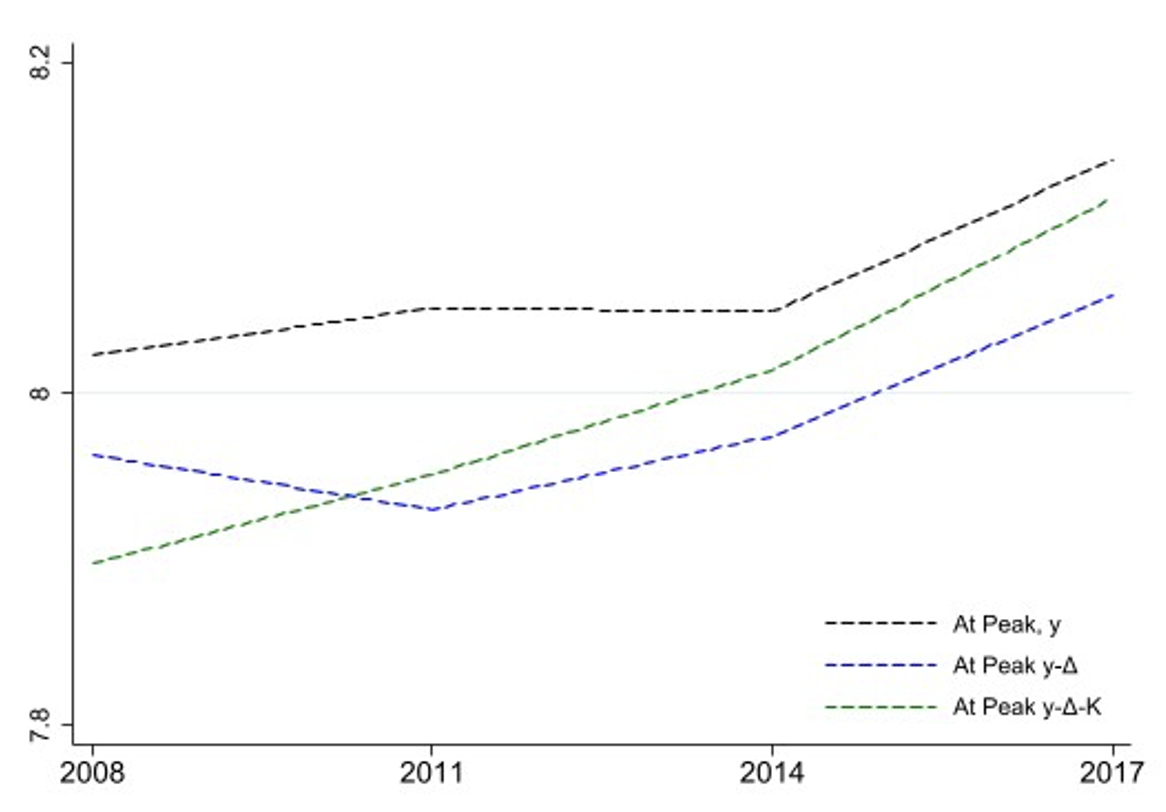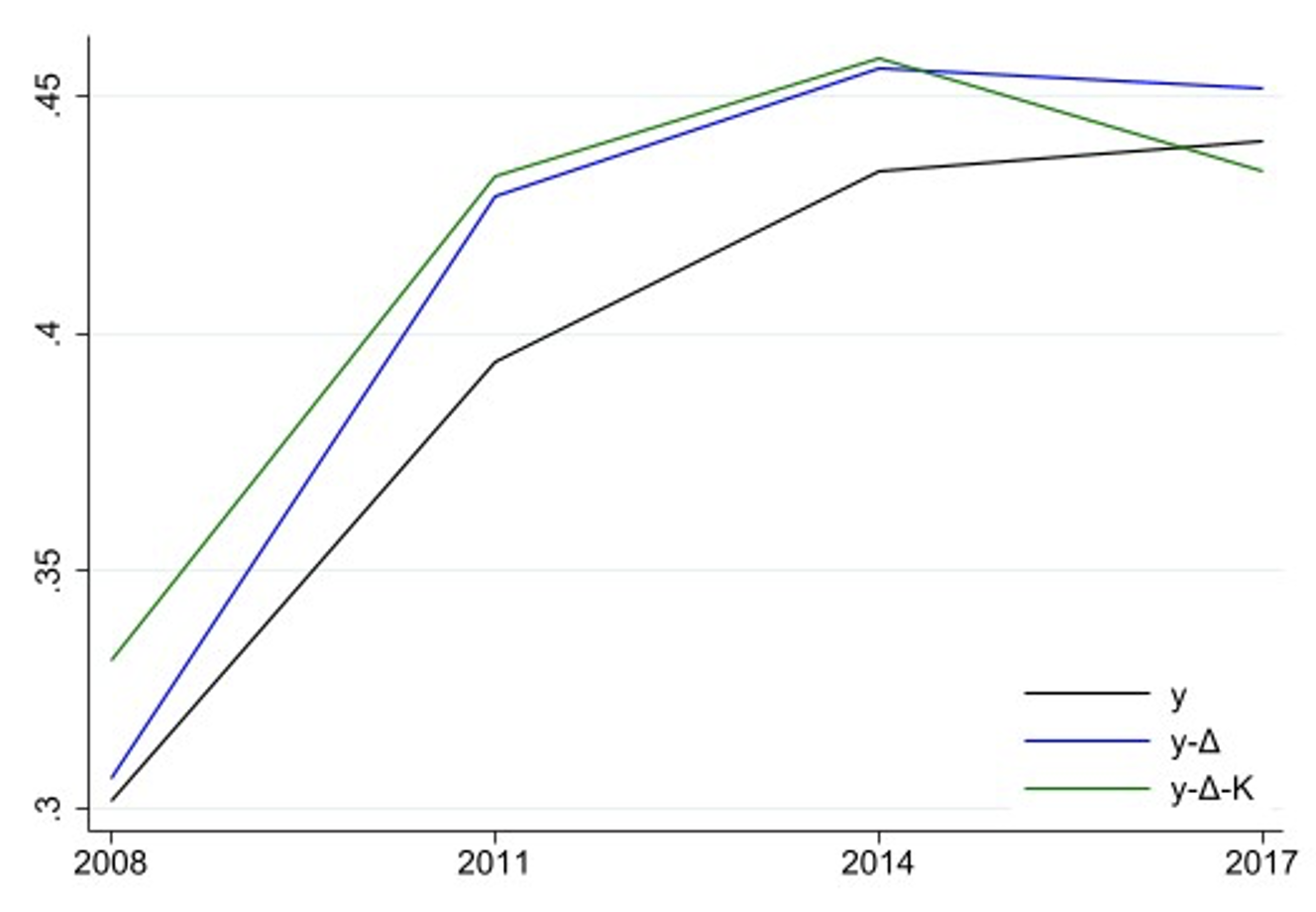Kiyotaki et al. (2011) show the strong redistributive effects of house price fluctuations between net buyers and net sellers of houses. Similarly, Glover et al. (2020) show that large fluctuations in earnings and asset prices in the US during the Great Recession have different consequences on welfare across generations: older home owners lose out more than the young because the decline in asset prices was large relative to the decline in wages. The importance of house price fluctuations for wealth inequality has been studied empirically in Kuhn et al. (2018), among others. In a recent paper, Dustmann et al. (2021) explore the effects of housing costs on inequality in disposable income net of housing expenditure in Germany since the mid-1990s. Their key finding is that changes in housing expenditures have exacerbated income inequality. This is particularly driven by the decline in the relative costs of home ownership versus renting.
In a new paper (Low and Sánchez-Marcos 2022), we focus on the impact of variation in house prices across the business cycle in Spain. We show the extent to which the variation in house prices over the cycle is an important driver of differences both in living standards and in inequality across otherwise similar homeowners. Further, we show the extent to which household labour supply responds to the price that was paid at the time of purchase. As argued by Attanasio and Pistaferri (2016), the extent to which differences in prices actually paid affect the dynamics of consumption inequality is an open question.
Households devote much of their lifetime income to the purchase of their residential home and, for most families, when to buy their main home is not a decision with much room for manoeuvre. However, the price they pay depends very much on the time of purchase and the point in the business cycle when they enter the housing market. This heterogeneity in the price of purchase can potentially have lasting effects, driving inequality in disposable income and changing labour supply decisions. We study the house price boom and bust of the 2000s in Spain. Spain is an interesting case because almost 90% of the real assets of families consist of real estate and most families, over 80%, live in an owner-occupied house. In addition, during the last two decades, house prices in Spain have undergone tremendous fluctuations: house prices in the country have generally doubled during the 1998–2007 expansion, while during the ensuing crisis, the price fell considerably to an average devaluation of about 40%.
The house price at the time of purchase changes the amount of resources needed to buy the same house with the same net wealth. This generates differences in income net of the commitments across households which differ only in their time of purchase. We focus on two issues arising from these differing commitments. The first is the impact on inequality of income net-of-housing costs: whether netting-off the additional costs of purchase in a housing boom increases or decreases inequality may depend on who is purchasing at different points in the business cycle. Cohorts of individuals who are exposed to large fluctuations in house prices at early ages may have greater inequality in income net of housing expenditures. Second, households may respond to smooth the effects of these housing commitments by changing non-housing consumption or by changing labour supply.
Adjusted income: Netting-off housing cost due to the time of purchase
In our analysis, we use the Family Financial Survey (2002-2017) conducted by the Banco de España. We construct a measure of the additional housing cost associated with buying at the peak of the market, rather than at other times. We compute a house price index and calculate the price that would have been paid at the average over the period. In other words, the deflated price reflects the additional cost for the same house, rather than the additional costs that may arise due to the type of house purchased differing over the cycle. We use this measure to calculate hypothetical mortgage payment and consider the difference between this payment and the payment implied by the actual price paid, holding mortgage conditions constant, Δ.
We subtract this difference from household income to obtain a measure of income adjusted for the extra cost associated with the time of purchase. We also compute the effect of adjusting mortgage conditions (interest rate) depending on the time of purchase but without adjusting prices, Κ.
In Figure 1 we decompose the effect of the two components that adjust income by time of purchase. In panel (a) we show the evolution of the median of the log of gross household income, the log of household income subtracting only Δ, and the log of household income subtracting both Δ and Κ for those who bought off-peak. The same variables are shown in panel (b) for those who bought at the peak. Those who purchased at the peak of house prices have higher incomes subsequently than those who purchased outside the peak, but their income net of house costs was lower. Differences in the interest rate attenuate the cost of paying a higher house price at the peak because interest rates were lower at the peak. We show the impact of Δ and Κ on household income for different households (similar to Dustmann et al. 2021, who compare renters and owners). The marginal effect, Δ, of purchasing at the peak relative to off-peak by income tercile increases from €275 in the first tercile to €493 in the third tercile. However, the value of Δ relative to income of those who bought at the peak is 18% in the first tercile, but only 8% in the third.
Figure 1 Median log income
a) Off peak
b) At peak
Note: The adjustment Δ is the difference in mortgage costs due to differences in the price at the timing of purchase and the adjustment Κ is the difference in mortgage costs due to differences in the interest rate at the timing of purchase. The year on the x-axis is the interview year, while the year of purchase affects individual values of Δ and Κ used to construct individual adjusted income.
Inequality
In Figure 2 we show that inequality in household income adjusted for housing cost is larger than in actual income, partly due to the variation in housing purchasing conditions within income bands. Interestingly, inequality in (y- Δ - Κ) is larger than inequality of (y - Δ). This is because households who benefited most from the lower interest rates during the peak are those further up the income distribution. The impact on inequality is of similar magnitude to removing public transfers during a boom, which gives a sense of the scale of impact on inequality. Further, we find that inequality in adjusted income increased faster over 2008 to 2017 than inequality in actual income.
Figure 2 Variance of log household’s income
Response of labour supply
These differences in the house price that households faced lead to changes in subsequent labour supply decisions. Clearly the house price that an individual pays is an endogenous choice depending on expectations about current and future earnings and so we instrument the actual price that was paid for the house with the regional house price at the time of purchase.
Our findings on the impact of house prices on employment differ for men and women. For men, purchasing when prices are higher leads to greater employment. Further, the OLS estimate is an underestimate of the effect of house prices. This is due to the fact that the employment expansion in Spain driven by the construction sector since the end of the nineties fuelled house purchases of individuals working in this sector, these individuals were more likely to lose their jobs after the collapse of the economy. The impact of the dynamics of the construction sector on earnings inequality is studied in Bonhomme and Hospido (2017). Our estimate of the effect of the house price at purchase being 10% higher is that employment is about 1 percentage point higher for men. For women, the OLS estimate shows a positive correlation between the house price and employment, but this disappears when we instrument the house price. In other words, those who anticipate working in the future choose to pay a higher price than the local average, rather than the higher price inducing greater employment.
Conclusion
Our conclusion is that the timing of house price purchase had significant impacts on spending power, on inequality, and on men's employment. This increase in men's employment among those facing high prices will have mitigated the impact of the house prices on incomes and income inequality.
References
Attanasio, O P and L Pistaferri (2016), “Consumption Inequality", Journal of Economic Perspectives 30 (2): 3-28.
Bonhomme, S and L Hospido (2017) ,"The cycle of wage inequality in Spain: The impact of the boom and bust in the housing market”, VoxEU.org, 4 September.
Bottazzi, R, S Trucchi, and M Wakefield (2019), “Labour Supply Responses to Financial Wealth Shocks: Evidence from in Italy", Fiscal Studies 42.
Daminato, C and L Pistaferri (2020), “Family labor supply and asset returns", European Economic Review 124.
Disney, R and J Gathergood (2017), “House Prices, Wealth Effects and Labour Supply", Economica 85.
Dustmann, C, B Fitzenberger, and M Zimmermann (2018), “Housing expenditures and income inequality: Shifts in housing costs exacerbated the rise in income inequality”, VoxEU.org, 22 October.
Glover, A, J Heathcote, D Krueger, and J-V Ríos-Rull (2020), “Intergenerational Redistribution in the Great Recession”, Journal of Political Economy 128(10): 3730-3778.
Kiyotaki, N, A Michealides, and K Nikolov (2011), “Winners and Losers in Housing Markets", Journal of Money, Credit and Banking 43(2-3):255-296.
Kuhn, M, M Schularick and U Steins (2018), “Asset prices and wealth inequality”, VoxEU.org, 9 August.
Low, H and V Sánchez-Marcos (2022), “Winners and Losers of House Price Booms and Busts”, CEPR Discussion Paper 17127.






